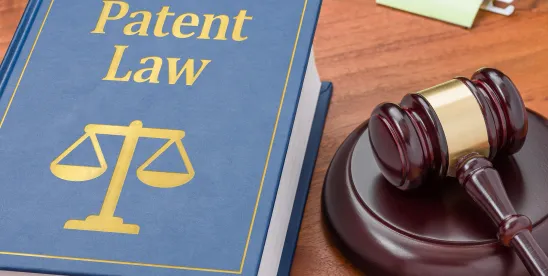In a significant decision, the Federal Circuit reversed the U.S. International Trade Commission’s (ITC) finding that claims of U.S. Patent No. 10,508,502 (502 Patent) were invalid under 35 U.S.C. § 101. The opinion addresses critical issues in patent eligibility jurisprudence, particularly regarding composition-of-matter claims and provides additional clarity for patent owners facing § 101 challenges.
Background of the Case
The case, US Synthetic Corp. v. ITC, involves petitioner’s allegations that various companies violated Section 337 of the Tariff Act by importing products that infringed its 502 Patent. The 502 Patent pertains to polycrystalline diamond compacts (PDCs) used in drilling applications.
At issue was Claim 1 of the 502 patent, which describes the structural and magnetic properties of the PDC as follows:
- A polycrystalline diamond compact, comprising:
- a polycrystalline diamond table, at least an un-leached portion of the polycrystalline diamond table including:
- a plurality of diamond grains bonded together via diamond-to-diamond bonding to define interstitial regions, the plurality of diamond grains exhibiting an average grain size of about 50 μm or less; and
- a catalyst including cobalt, the catalyst occupying at least a portion of the interstitial regions;
- wherein the un-leached portion of the polycrystalline diamond table exhibits a coercivity of about 115 Oe to about 250 Oe;
- wherein the un-leached portion of the polycrystalline diamond table exhibits a specific permeability less than about 0.10 G∙cm3/g∙Oe; and
- a substrate bonded to the polycrystalline diamond table along an interfacial surface, the interfacial surface exhibiting a substantially planar topography;
- wherein a lateral dimension of the polycrystalline diamond table is about 0.8 cm to about 1.9 cm.
The ITC’s Ruling
The ITC’s Administrative Law Judge (ALJ) ruled the claims were patent-ineligible under § 101, reasoning that while the claimed PDC was a physical product, its claimed magnetic properties—coercivity, specific permeability, and specific magnetic saturation—were merely side effects of the manufacturing process and did not define structural elements. The ALJ concluded that the claims were directed to an abstract idea, namely: unintended “results or effects” of the manufacturing process. A divided Commission affirmed, rejecting petitioner’s argument that magnetic properties are structural or indicative of structure, and instead agreeing with the ALJ that the claimed properties were not a sufficiently concrete structure but rather a reflection of natural phenomena.
The Federal Circuit’s Analysis
The Federal Circuit’s decision, delivered by Judge Chen, reversed the ITC’s ruling on patent eligibility, holding that the claimed invention was not directed to an abstract idea but instead to a specific, non-abstract composition of matter, namely, a PDC defined by its constituent elements.
The court rejected the ITC’s reasoning that the magnetic properties were merely side effects of a manufacturing process, and instead found that the relationship between the measured properties and the structure of the PDC was sufficiently disclosed in the patent specification and magnetic properties such that the claimed magnetic properties further define the structural characteristics of the claimed product. In this regard, the Federal Circuit clarified that patent claims do not need a “perfect proxy” for structural properties to survive § 101 scrutiny. The court noted, “The disclosed relationship here is sufficient for § 101, where we are trying to ascertain as a matter of law whether a patent claim is directed to a specific implementation of an idea or merely just the idea itself.”
The ruling also noted that the ITC’s reliance on cases involving software and algorithmic patents, was inappropriate. Unlike those cases, which involved performing functions using generic computer components, the 502 Patent’s composition-of-matter claim defined a tangible, physical product. The Federal Circuit drew a clear distinction, stating, “The claimed PDC is not an abstract result of generic computer functionality, but instead is a physical composition of matter defined by its constituent elements, dimensional information, and inherent material properties.”
Why this Case is Important
This decision has significant implications for composition-of-matter claims. It provides another foothold for protecting physical inventions, particularly in materials science, chemistry, and engineering. Had the ITC’s ruling stood, it could have set a dangerous precedent, casting doubt on patents that define materials by their measurable properties rather than their physical structure. The ruling also provides additional clarity on how § 101 considerations apply to composition-of-matter patents, pushing back against overbroad interpretations of the “abstract idea” exception.
This decision also draws a line against extending the applicability of software and business method jurisprudence into cases where patents define physical structures or claimed parameters that are concrete, objective measurements for defining the invention.
Ultimately, this case serves as an important precedent for patent owners, particularly those in industries where innovations are defined by measurable material properties. By reaffirming the eligibility of composition-of-matter patents, the Federal Circuit provided a clearer path for protecting physical innovations under § 101.
Key Takeaway
The Federal Circuit makes clear that the broader context of the entire patent is important in the analysis. When including claims using non-structural properties, be sure that the specification describes a sufficient correlation between the claimed effects/results and any unclaimed physical characteristics. These correlations should be concrete and meaningful, rather than merely speculative. The specification should sufficiently disclose the relationship between the claimed properties and the structure.
For further details, patent professionals are encouraged to review the full court opinion and consider how this decision may influence their current and future portfolio and/or litigation strategies.



 />i
/>i

